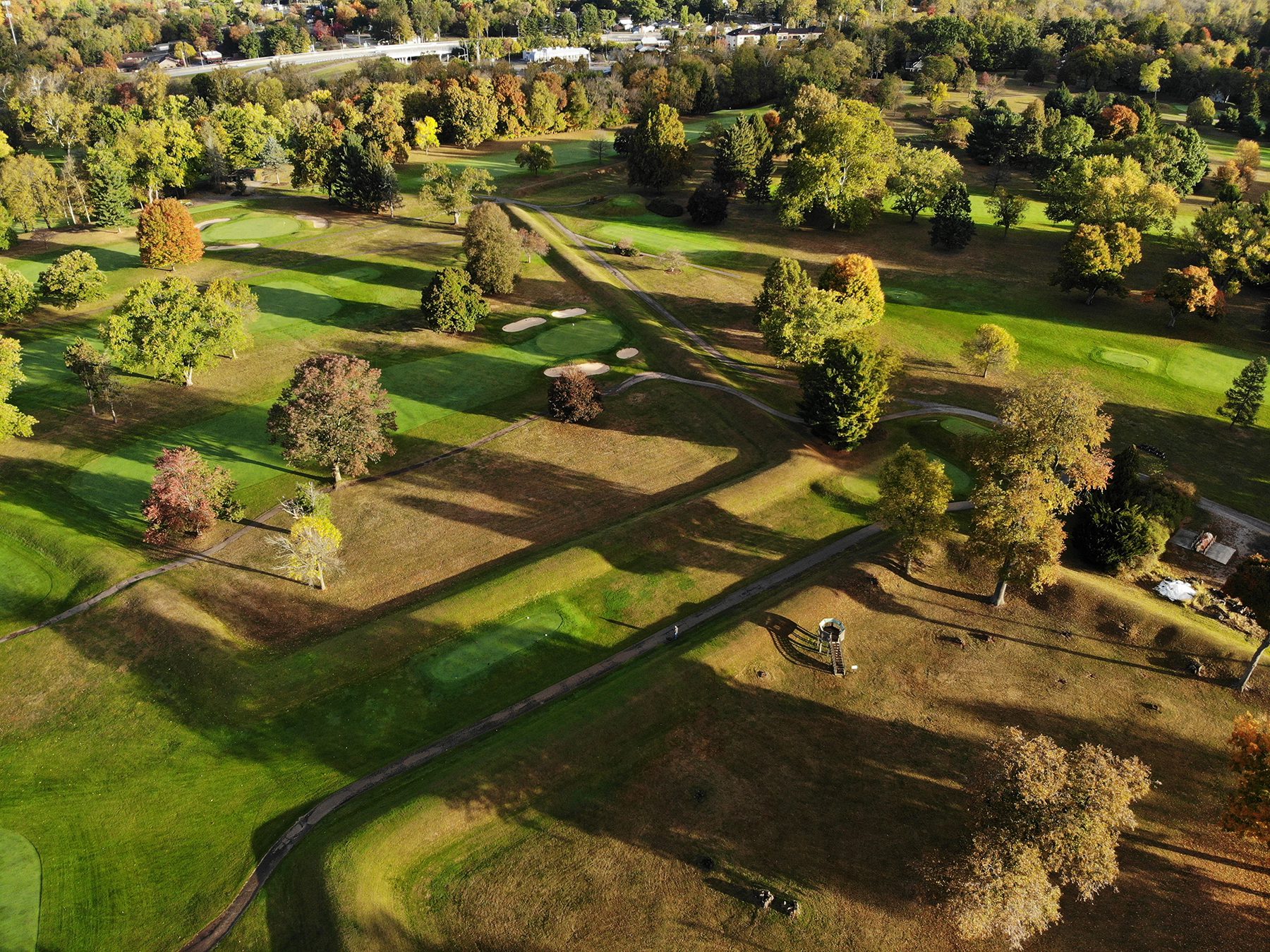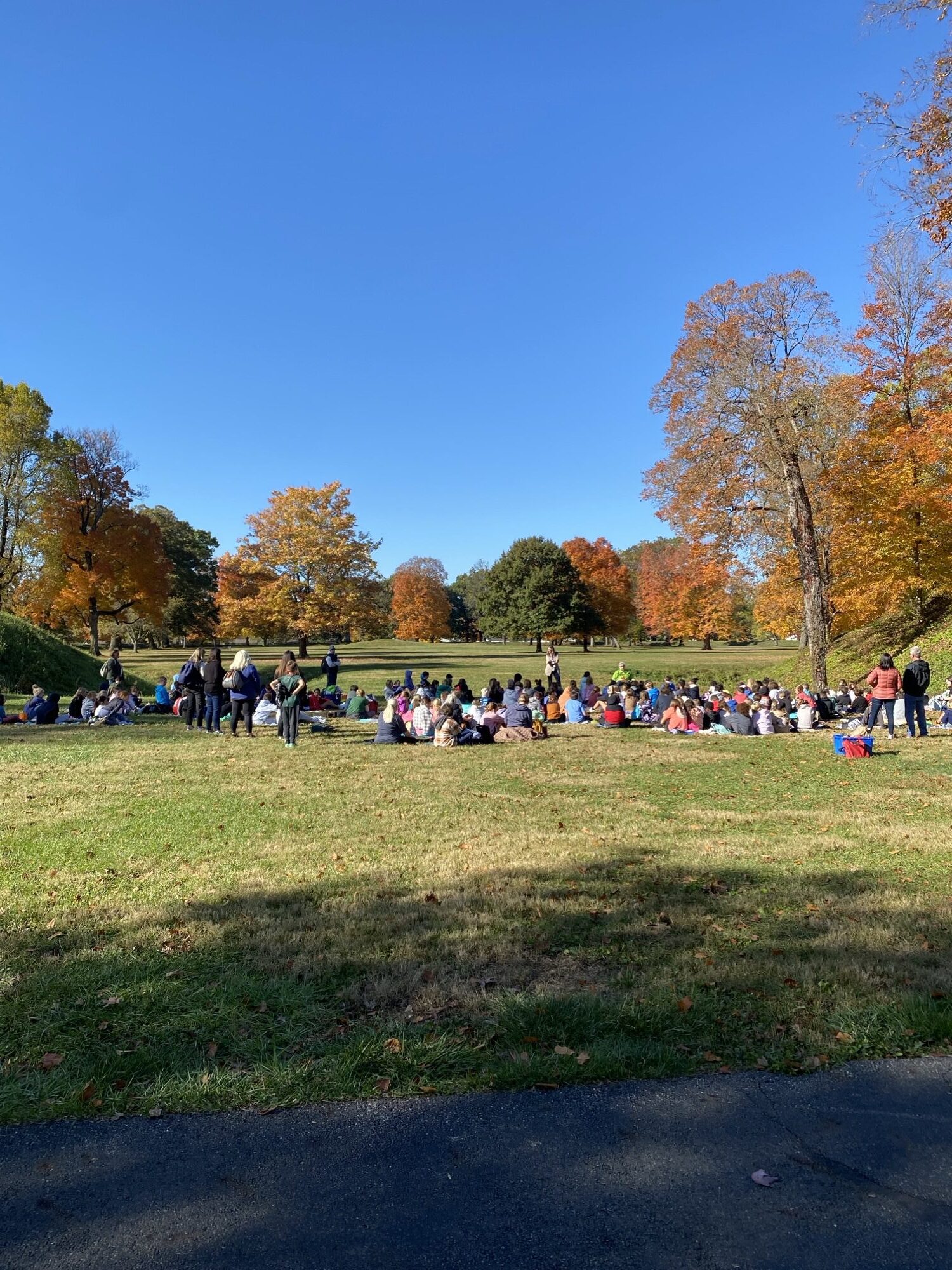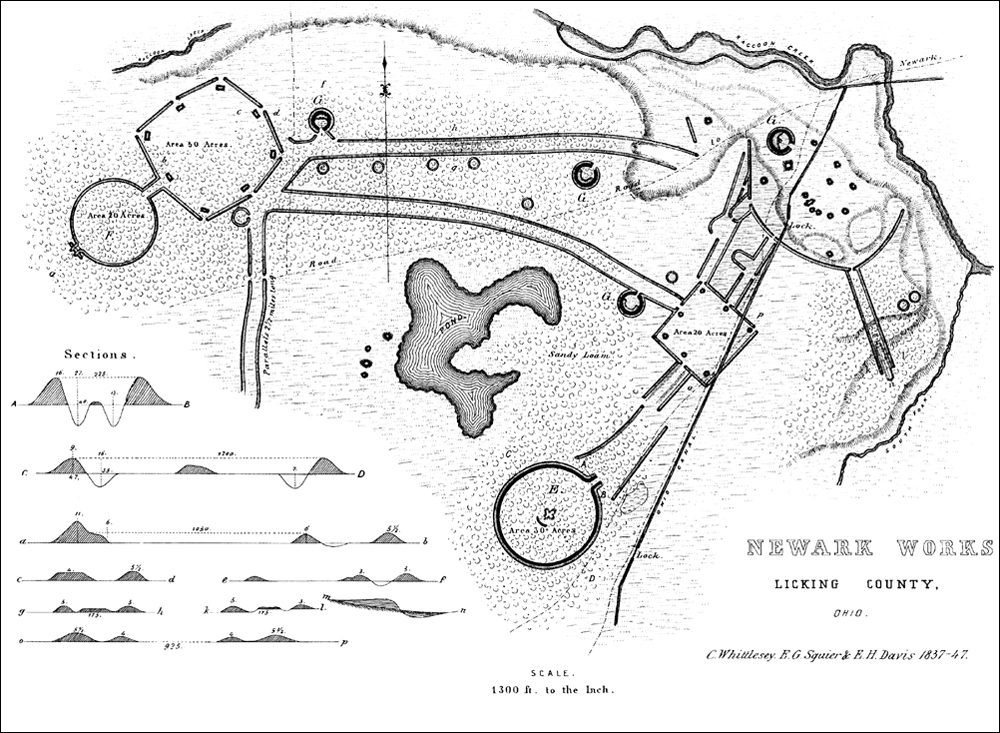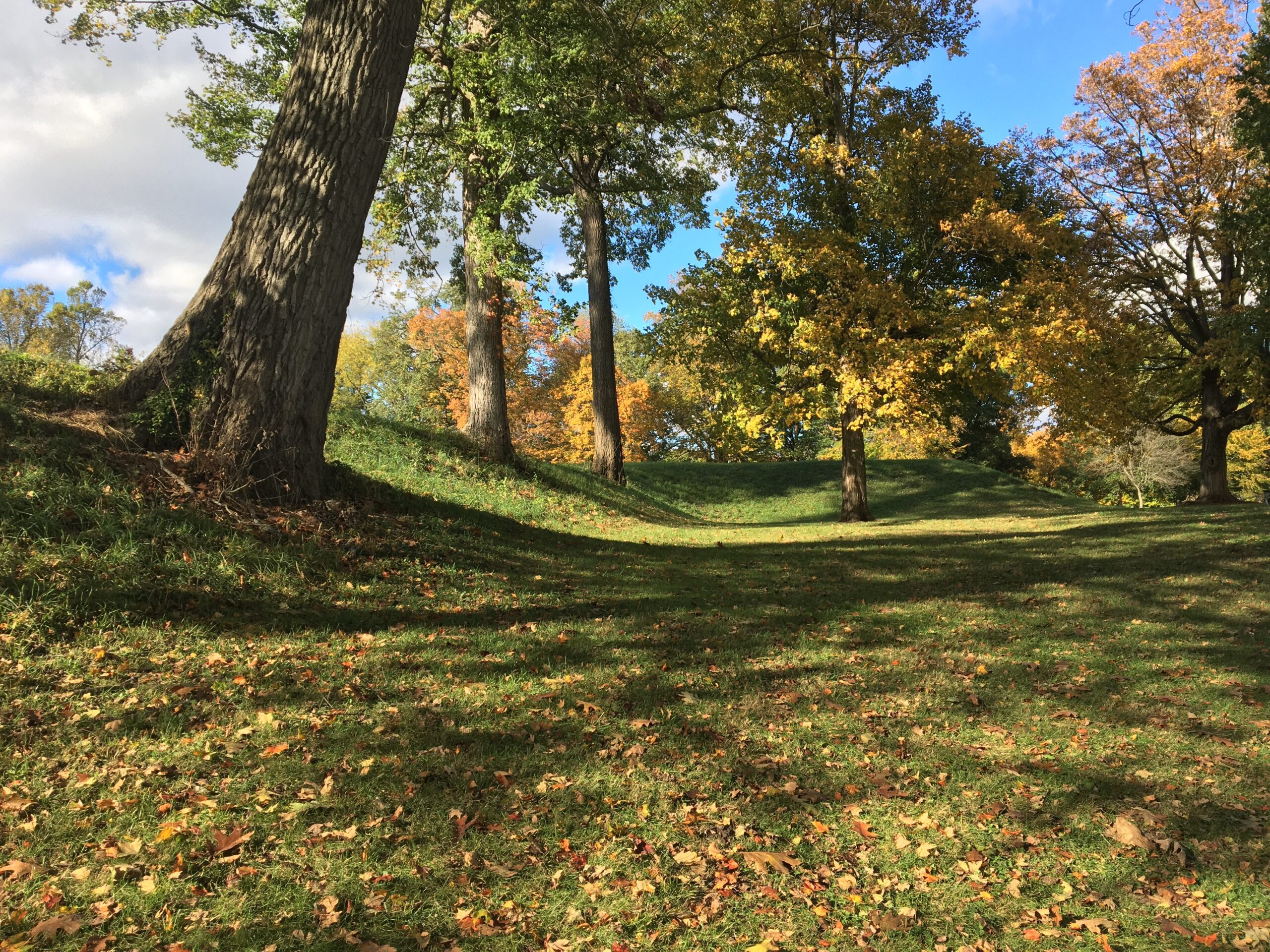The Newark Earthworks are in present-day Newark and Heath within the boundary of Licking County, Ohio. Of this once 4-square-mile complex three portions are preserved:
The Great Circle – The location of the Newark Earthworks Museum. The site consists of a circular earthwork formed by a tall continuous earthen wall that encompasses 30 acres of land. The wall is lined by a deep ditch on the inside of the earthwork. The Museum is located at the top of a slight rise with a paved pathway leading to it. There is no paved pathway into the interior of the Great Circle.
The Great Circle Museum
Address: 455 Hebron Road, Heath, OH 43056
The Wright Square – a small portion of a square earthwork enclosure positioned northeast of the Great Circle. This site provides a perspective of how development has impacted earthworks not only in Newark but all over the state of Ohio.
Address: James Street, Newark, OH 43055
The Octagon – two combined earthwork enclosures positioned above the floodplain of Raccoon Creek. This earthwork includes a 20-acre circle and a 50-acre octagon, connected by a small passageway. The Octagon recently opened for full public access on Jan. 1, 2025.
Address: 125 N 33rd Street, Newark, OH 43055
The Museum located at the Great Circle includes a bookstore and interpretive center. Our current hours of operation are Thursday, Friday, and Saturdays 10 a.m. to 4 p.m.

Passageway connecting the Octagon to the Observatory Circle at the Octagon Earthworks. Photo by Aaron Keirns.
Dogs are welcome on all the sites. Please keep your furry companions leashed and take advantage of our waste bags and remove messes that they may create on the grounds.
Enjoy the earthworks but please do not climb on the walls. We would like to keep these walls standing tall for 2,000 years after you visit them. Foot traffic will cause damage over time.
There are now FREE tours offered at the Octagon Earthworks beginning at Noon, Wednesday–Sunday.
SPECIAL TOURS – led by Senior World Heritage Archaeologist Brad Lepper! Beginning at 12:30pm on the first and third Friday of the month from April to October. These tours are FREE and do not require pre-registration.
Great Circle Earthworks – First Friday beginning at The Great Circle Museum
Octagon Earthworks – Third Friday beginning at the Octagon Visitor Center
Regular guided tours of the Great Circle are offered from March through November at 2:00 pm on Thursdays, Fridays, and Saturdays. Tours will include a 45 min walk through the Great Circle.
Tour Admission
$10 per person aged 12 and up
$7 for seniors (aged 65+)
$5 dollars for children aged 5 to 12
Children under 5 years of age are free.
Tour admission is discounted for all Ohio History Connection Members.
There is no registration or sign-up required for regularly scheduled tours. Visitors that are planning on attending the tours are asked to stop at the front desk of the Great Circle Museum to purchase tickets prior to tour departure. All tours will begin on the front patio of the museum.
Tours are led rain or shine. Please check the weather and dress accordingly. There are no paved walkways into the earthwork.
To schedule a group tour outside of regularly scheduled hours please contact our site manager via email ([email protected]) or call our office at 740.344.0498.
 Field Trips
Field Trips To schedule a field trip, reach out to our site manager at least 4 weeks prior to the date you would like to visit. We ask that you try to plan at least 3 hours for field trips. The experience will include a guided tour and three activities in which students will engage with earthwork planning and construction and the history and culture of the Middle Woodland Period in Ohio. All activities are tailored to align with 4th grade Ohio Social Studies standards. However, tours and activities can be adapted to accommodate most grade levels between elementary and high school. The admission fee (including guided activities) will be $5 per student in attendance. Admission is free for teachers and chaperones. Picnic facilities available for sack lunches and snacks.
There are shelter houses available for picnics and gatherings at the Great Circle. We DO NOT make reservations for these spaces; they are first come first serve. The site manager holds the authority to close these spaces off for site related events and activities.
Portable restrooms are available near the shelter houses from mid-April to early September. They are open and available to visitors daily.
The Newark Earthworks is one of many Hopewell Ceremonial Earthworks built by American Indians 2,000 years ago. This site includes geometric shapes interconnected by low walls all built from earth carried by human hands and laid intentionally one basketful at a time. An estimated 7 million cubic feet (approximately 21 million baskets) of earth were used to construct the Newark Earthworks which covered over four-square miles of what is now today the city of Newark, Ohio. Many groups of American Indians from all over North America were gathering at the Newark Earthworks to practice spiritual traditions, celebrate and connect with one another and the world around them.

Map of the full Newark Earthworks Complex included in “Ancient Monuments of the Mississippi Valley” compiled by Ephraim Squier and Edwin Davis published in 1848.
The Octagon portion of the Newark Earthworks highlights the depth of planning and connection to the broader patterns of the universe embedded in the construction of Hopewell Ceremonial Earthworks. The Octagon is aligned with the lunar cycle and every 18.6 years the moon rises directly through the passageway linking the Observatory Circle and the Octagon. Each aspect of these earthwork complexes was created and designed with intention and care, a testament to the genius, cooperation and devotion of the American Indian peoples who created them thousands of years ago.
The earthwork sites in Ohio were sacred spaces not just for local American Indian peoples but groups of American Indians from all over North America. Exotic (non-local) materials were being brought by the people gathering at these sites from over 1800 miles away. American Indians coming to gather at the Hopewell Ceremonial Earthworks were bringing obsidian from the Rocky Mountain region, lightning whelk shells and shark teeth from the Gulf of Mexico and Atlantic Ocean, mica from the Blue Ridge Mountain Region and copper from the Upper Peninsula of Michigan. All these materials were transformed into ceremonial items that were laid to rest in these earthworks in Ohio.
Despite the fact that a great deal of the Newark Earthworks complex was lost to agriculture and development, two aspects of it remain: the Octagon and the Great Circle. The citizens of Licking County had the foresight to preserve these spaces. They are still used as places of coming together, sharing and celebrating but maybe in different ways than originally intended. Regardless, they are sacred spaces and hold a special place in the hearts of many. The local communities around the earthwork remember it as the county fairgrounds and as a place for family reunions and gatherings. But the site is especially meaningful to American Indian peoples. Their ancestors constructed the earthen walls that make up the Newark Earthworks and many other earthwork sites. They are the ones who lived, worked, played and celebrated on the land that is now Ohio for thousands of years.

Exterior wall of the Great Circle Earthwork. Photo courtesy of Brad Lepper.
In September of 2023, the Newark Earthworks, along with 6 other Hopewell Ceremonial Earthworks, were inscribed on the UNESCO World Heritage List. These other sites include Fort Ancient and 5 sites within Hopewell Culture National Historical Park. These earthworks are masterpieces of creative human genius and are lasting marks of a culture that is no longer present that was influential to shaping the landscape. Learn more about these sites by visiting the Hopewell Ceremonial Earthworks webpage!
You can also explore the details of our inscription on the UNESCO World Heritage website.
Join us in preserving the Newark Earthworks and telling the story of this important site by lending a helping hand with site maintenance, educational and interpretive programs, and more! Find out more about volunteering at the Ohio History Connection here.
Please visit this webpage regularly or check our Facebook Page to get updates and info about upcoming events.